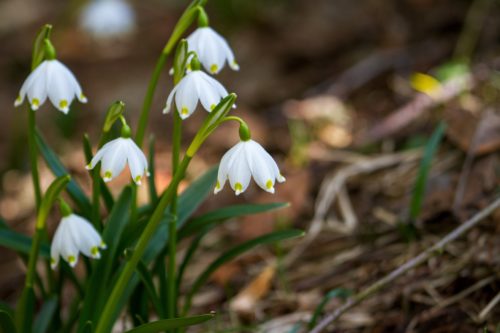Be-a-Better-Gardener Naturalizing Bulbs
Snowdrops (Galanthus nivalis) naturalize easily and create a spontaneous, natural look as a wood’s edge planting.
By Thomas Christopher
It’s a seductive idea: you plant spring-blooming bulbs throughout the lawn and maybe the wood’s edge, and then do nothing except admire, depending on them to return and bloom on their own, year after year. That’s the pitch that’s made for “naturalizing” bulbs. Of course, though, it’s not quite that simple. Naturalizing bulbs in this fashion actually takes planning and preparation and afterwards requires some appropriate care. Satisfy these basic requirements, however, and you can in fact persuade bulbs to colonize your yard in seemingly wild abandon. Indeed, they may not only persist, but in some favorable cases may actually multiply and spread.
The key to success is selecting the right sorts of bulbs. You’ll need robust bulbs that are truly perennial. Tulips and Dutch hyacinths, for example, won’t do, because they start to degenerate within a year or two of planting. Better choices include daffodils (Narcissus spp.), crocuses (Crocus spp.), snowdrops (Galanthus nivalis), grape hyacinths (Muscari armeniacum), Siberian squills (Scilla siberica), and glory of the snow (Chionodoxa luciliae).
To naturalize bulbs successfully, their foliage must be left intact until it withers on its own as the bulbs enter summer dormancy. This is why the best choices for lawn areas, I have found, are the very early blooming bulbs such as snow crocuses (Crocus chrysanthus), snowdrops, and glories of the snow. These precocious flowers make their growth and bloom very early in the spring and are already going dormant by the time the lawn needs its first mowing. Daffodils, in contrast, flower later and their leaves don’t wither until early summer. When I tried planting daffodils in a lawn, the grass grew as high as a hayfield before the daffodils went dormant. I’ve found that narcissuses are better suited to naturalizing in lightly shaded woodland areas.
There are a couple of points to keep in mind as you select a spot in which to naturalize bulbs. The first is that bulbs typically require a well-drained location. In particular, they prefer dry conditions when they are dormant in summertime. Low-lying areas that tend to stay soggy for prolonged periods after rainstorms are not suitable. Bulbs also require considerable sunlight, generally at least four hours of bright light daily. However, areas that are shaded in summertime by deciduous trees can be good candidates for the early spring bloomers, as they make their growth and go dormant before the trees leaf out.
The point of naturalizing, as the name indicates, is to create a spontaneous, natural look. For this reason, you should avoid any hint of symmetry or formality in the arrangement of the bulbs. I’ve known gardeners who guarantee that by simply tossing out handfuls of bulbs into the selected area and planting them wherever they land. I prefer a more measured approach, arranging the bulbs in an irregular pattern in the chosen spot, making sure that each bulb is the recommended distance from the others.
Small bulbs such as crocuses need greater numbers to create a visual impact: I prefer to plant them in groups of 30 or more. Daffodils, which are larger and more imposing, can make a statement in groups of as few as 5 to 10. In general, the more you plant, the better the effect will be. If your budget is tight, plan to add new groups to your naturalization program over a period of years.
When it comes to actually planting the bulbs, I use an electric drill equipped with a soil auger. Whether you do that or resort to a trowel, dig the holes to the depth recommended by the bulb nursery and be sure to plant the bulbs with the growing tip upward. That’s usually the pointed side of the bulb, but if you are in any doubt about which side of the bulb is the top, plant it on its side.
Once the bulbs are in place, fill the holes almost to the top with compost, finishing with a bit of the original soil and replacing the turf if you removed any. Broadcast fertilizer over the planting area, using an organic or synthetic product specially formulated for bulbs at the rate recommended on the label. Water it in and wait for spring. Enjoy the show – if you’ve done your work properly, there will be many return performances.
Thomas Christopher is the co-author of “Garden Revolution” (Timber Press, 2016) and is a volunteer at Berkshire Botanical Garden. berkshirebotanical.org
Be-a-Better-Gardener is a community service of Berkshire Botanical Garden, one of the nation’s oldest botanical gardens in Stockbridge, MA. Its mission to provide knowledge of gardening and the environment through 25 display gardens and a diverse range of classes informs and inspires thousands of students and visitors on horticultural topics every year. Thomas Christopher is the co-author of Garden Revolution (Timber press, 2016) and is a volunteer at Berkshire Botanical Garden. berkshirebotanical.org.




